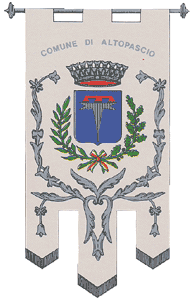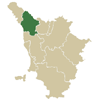|  Inhabitants in 1991: 9.976
Inhabitants in 1991: 9.976
 The
Altopascio territory extends for 28,70 square kilometres in the low threshold
which allows the Valdinievole to communicate with the plain to the east
of Lucca, between the extreme offshoot of the Pistoia Apennine and the
hills of Cerbaie. Constituted in 1881 with the districts of Altopascio,
Spianate and Marginone, detached from the municipality of Montecarlo,
it reached its present day aspect in 1925 when it aggregated the
district of Badia Pozzeveri from Capannori. The
Altopascio territory extends for 28,70 square kilometres in the low threshold
which allows the Valdinievole to communicate with the plain to the east
of Lucca, between the extreme offshoot of the Pistoia Apennine and the
hills of Cerbaie. Constituted in 1881 with the districts of Altopascio,
Spianate and Marginone, detached from the municipality of Montecarlo,
it reached its present day aspect in 1925 when it aggregated the
district of Badia Pozzeveri from Capannori.
The castle recorded for the first time in 952, was in the Medieval
era the centre of irradiation of the religious order of hospital workers
called the Knights of Altopascio, who founded a hospice
there – cited for the first time in 1084 – with the function
of aiding and giving shelter to the travellers and pilgrims who travelled
the via Francigena. The order which knew moments of great prosperity
particularly between the XII and XIII centuries, in so much as to spread
even overseas it began to decline in the 1300 and in 1472 the Pontiff
Sisto IV conceded the patronage of the hospital to the Fiorentina family
dei Capponi; but in 1544 Cosimo I dei Medici laid claim to it from himself
and destined the immense assets to the Knightly Order of Santo Stefano,
recently constituted to defend Christianity against the Turks. Altopascio
was a possession of the Lucca republic until 1338 when it passed
to Firenze together with most part of the Valdinievole. In 1363 it was
besieged and burnt down by Pisa. On its territory the historic battle
was held in 1325 which saw the defeat of the Fiorentini by the Lucca militia
of Castuccio Castracani degli Antelminelli.
Places to visit:
Il Piaggione, a complex of silos
built in 1774 by Pietro Leopoldo, which holds the Municipal Library
and the Centre for the documentation of the daily life of the antique
community.
S. Jacopo Maggiore, reconstructed in 1827 on
a preceding church of the XII century. Ancient imposing tower with
a crenellated belfry from 1280 which preserves the bell called “La
Smarrita” (The Lost) because it was rung at eventide to call
in the people who were in the surrounding woods before nightfall. |
Historical info reproduced upon authorization of Regione Toscana - Dipartimento della Presidenza E Affari Legislativi e Giuridici
Translated by Ann Mountford |